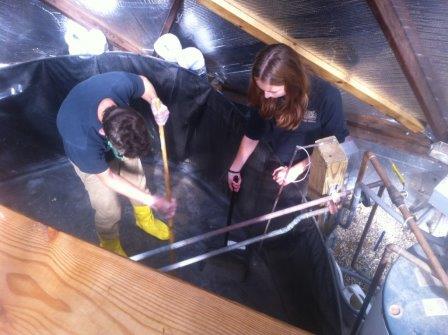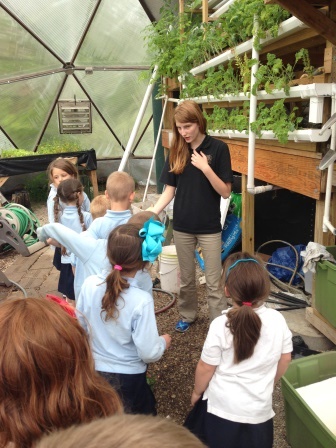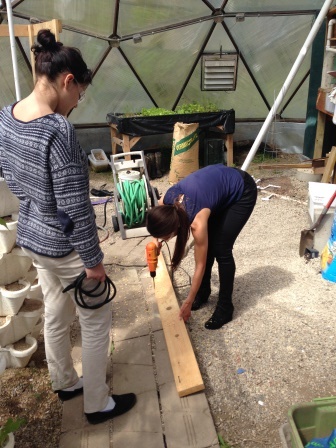 Dead catfish. Electrical power failures. Not everything went exactly as hoped for Kris Galoci’s high school students at Grand Traverse Academy (GTA), a charter school in Traverse City, Michigan.
Dead catfish. Electrical power failures. Not everything went exactly as hoped for Kris Galoci’s high school students at Grand Traverse Academy (GTA), a charter school in Traverse City, Michigan.
Yet according to her and her students, the setbacks in the closed-loop aquaponics system used in their project-based science class are part of the learning process. The system itself consists of a water tank inside a domed greenhouse in which fish and plants lead a beneficial co-existence. Galoci inherited the system when another teacher left GTA.
“I wanted to go beyond building and maintaining the system to create a substantial, rigorous curriculum,” Galoci said. She did this by introducing an entrepreneurial element to the class, letting students work their way out of the inevitable technical problems that arose, and using the system to discuss larger environmental issues.
Students as Entrepreneurs
 Students in different grades can enroll in her environmental studies course, with older students taking on leadership roles. In addition to working on the system together, small groups design and develop projects using the system. For example, 11th grader Andrew Lasko built a vertical growing wall and flood drain system as a way to minimize the environmental footprint.
Students in different grades can enroll in her environmental studies course, with older students taking on leadership roles. In addition to working on the system together, small groups design and develop projects using the system. For example, 11th grader Andrew Lasko built a vertical growing wall and flood drain system as a way to minimize the environmental footprint.
Galoci arranges for the students to present their ideas to business and community partners. “They have to convince ‘investors’ that their design can solve a problem, such as providing food or minimizing water usage,” Galoci said. “I bring in a business side to the class—that environmental solutions can bring value to the economy.” The “investors” are given play-money and make decisions about which ideas they find most valuable. The class then develops some of the winning ideas further.
Galoci suggested that the student pages What Makes Up an Environmental Issue? and Analyzing the Issue from PLT’s secondary module Exploring Environmental Issues: Focus on Forests can help students prepare presentations about an environmental issue of their choice.
Ada Takacs, Michigan PLT coordinator, has listened to the GTA student pitches several times, and says she always comes away impressed. “It is amazing to see how the students mature from one year to the next, and see how their ideas, their demeanor, and their speaking skills grow,” she said.
In 2014, PLT held its annual international conference in Traverse City. Takacs noted that GTA students (as well as younger students from Mill Creek Elementary School) made well-received presentations at the conference to educators, resource managers, national PLT leaders, and others. Through a grant from the Albert I. Pierce Foundation, a grant from the national PLT program, Forest Stewardship Initiative funds, and other support, Michigan PLT has provided support to GTA, Mill Creek, and other schools throughout the state for environmental education, particularly related to outdoor learning.
Dealing with Setbacks
 “Kids like project-based learning, but it has its challenges,” Galoci acknowledged. A typical 50-minute class period can present time-management issues, and she said her students often spend parts of their lunch periods or after school in the greenhouse.
“Kids like project-based learning, but it has its challenges,” Galoci acknowledged. A typical 50-minute class period can present time-management issues, and she said her students often spend parts of their lunch periods or after school in the greenhouse.
Then there are issues like dead fish, such as when the electrical power went out for an extended period or when an automatic fish-feeding system failed.
“It all turns into a learning experience,” Galoci said. Recalling a small fish kill that occurred earlier in the year, she said, “I could have said, ‘here’s what happened, here’s how to fix it.’ But I decided to be hands-off and let them figure it out.” She also brought in the fact that while the dead fish were a disappointment for the class, “we discussed people who count on farming for their livelihood.”
Her students appreciate what they learn from this approach. “I learned that you have to think of every bad situation and try to fix it before the system has a problem,” said Lasko, commenting on his vertical systems. “Also I learned that taking my time and doing things the right way is the best way, and not taking shortcuts.”
Ella Bush, another student, applied lessons learned from dissecting a salmon to analyzing why the catfish died. “We lost some of our fish, and we had to discover what was wrong with them. By dissecting the salmon, I had a better understanding of what was going on in the [cat]fish system,” she said.
“The students come up with criteria that their systems should meet,” Galoci said. “Then usually, it’s design, build, back to the drawing board. The trial-and-error aspect is huge.”
Extending the Learning
Beginning in 2015-2016, the aquaponics project became part of a course entitled Environmental Sustainability Engineering. Students used the greenhouse to grow algae for biofuels, for example, and move beyond food issues. “I want them to walk away from the class with the realization that we have a finite number of resources,” Galoci said. She said students are working toward zero-waste on the school campus through recycling, composting, and other measures.
Notes on Closed-Loop Aquaponics, Large and Small
According to the U.S. Department of Agriculture, aquaponics is a “hybrid food growing technology that combines aquaculture (growing fish) and hydroponics (growing veggies in non-soil media and nutrient-laden water).”
At Grand Traverse Academy, teacher Kris Galoci explained, a water tank stocked with catfish takes up about half of the ground space in a domed greenhouse on the school campus. They stock the tank with catfish. Students have experimented with different vegetables but have found most success with leafy greens, tomatoes, and peppers.
“The water passively heats during the day, and releases the heat during the night,” she said. “Fish waste in the water—which is converted by bacteria, so bacteria play a critical role—is converted into a usable form by the plants. The fish waste ultimately becomes fertilizer for plants. Cleaned water is returned back to the fish tank. We are producing food with the fish and also with the plants.”
Galoci noted schools that do not have the space or equipment for such a large system can adapt the system. “It can be done on a small scale inside a classroom, with a fish tank and a few plants,” she suggested.
Photos courtesy of Grand Traverse Academy.


